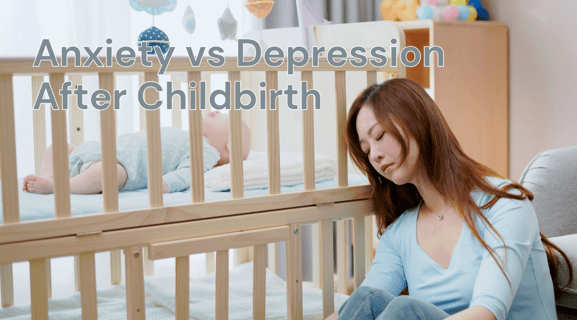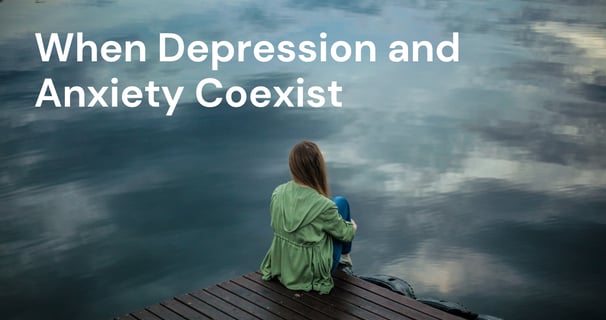Anxiety vs Depression After Childbirth: Understanding the Differences
7/1/20255 min read
The postpartum period is often described as a rollercoaster of emotions, and not without reason. The arrival of a newborn brings seismic changes to one’s physical, emotional, and mental landscape. For some, these shifts settle with time and support. For others, the emotional turbulence takes the shape of postpartum depression, postpartum anxiety, or sometimes both.
Although these conditions can overlap, they are distinct in how they show up, how they feel, and how they’re best treated. Understanding the difference between postpartum depression and postpartum anxiety is key, not only for those experiencing them, but for the loved ones and healthcare providers supporting their journey.
At Peace Temple, we work with new mothers and fathers who often ask, “Is what I’m feeling depression or anxiety?” The answer isn’t always simple, but it’s always worth exploring.


Why the Distinction Matters
Both postpartum anxiety and postpartum depression fall under the broader category of perinatal mood and anxiety disorders (PMADs). However, postpartum depression tends to receive more public attention, which means that postpartum anxiety often goes unnoticed or misunderstood. This can lead to misdiagnosis, untreated symptoms, and prolonged distress for new mothers. Understanding the differences not only helps individuals better recognize and articulate their experiences, but also enables clinicians to offer the right treatment and families to provide more effective support.
What Is Postpartum Depression?
Postpartum depression (PPD) is a mood disorder that typically emerges within the first few months after childbirth but can appear anytime within the first year. It is marked by a persistent low mood, a sense of hopelessness, and emotional disconnection. Common symptoms include frequent crying, a feeling of numbness or emptiness, a loss of interest in previously enjoyed activities or bonding with the baby, changes in appetite or sleep patterns that are unrelated to the baby’s needs, feelings of low self-worth or excessive guilt, and extreme fatigue or lack of motivation. Some mothers may even experience thoughts of self-harm or wishing to disappear. Women often describe it as being stuck in a fog or feeling like they’re failing as a parent, even when they are doing everything right. At Peace Temple, our therapists provide compassionate, non - judgmental support to help mothers navigate these emotions and reconnect with their lives meaningfully.
What Is Postpartum Anxiety?
Postpartum anxiety (PPA) is just as common as PPD—affecting up to 20% of new mothers—but it’s frequently misinterpreted as typical new parent worry. In contrast to the sadness associated with depression, postpartum anxiety is dominated by racing thoughts, persistent worry, and physical symptoms of tension or panic. Symptoms often include excessive concern about the baby’s safety, an inability to relax or quiet the mind, physical sensations such as heart palpitations, dizziness, or chest tightness, difficulty sleeping despite feeling exhausted, irritability, and repetitive checking behaviors (like constantly monitoring the baby's breathing). Mothers often report a sense that something terrible is about to happen, despite having no logical reason for the fear. At Peace Temple, our postpartum anxiety program offers proven methods like cognitive-behavioral therapy (CBT), mindfulness practices, and somatic tools to help manage both intrusive thoughts and uncomfortable physical symptoms.
Key Differences Between Postpartum Depression and Postpartum Anxiety
While there can be overlap between the two conditions, certain distinctions stand out. Postpartum depression tends to involve emotions of sadness, emptiness, and hopelessness, whereas postpartum anxiety is characterized more by fear, nervousness, and a sense of impending doom. In terms of thought patterns, depression often brings self-critical ideas like “I’m a failure” or “I’m a bad mom,” while anxiety generates constant worry, typically focused on the baby’s safety, such as “What if something bad happens?” The physical experience also differs: depression is often associated with fatigue, changes in appetite or sleep, and a general sense of heaviness, while anxiety comes with more acute physical symptoms like a racing heart, restlessness, and panic. Behaviorally, those with depression may withdraw or feel disinterested, while those with anxiety might become hypervigilant, engage in frequent checking behaviors, or avoid certain situations out of fear. The emotional risk focus also varies—depression centers on self-worth, whereas anxiety fixates on perceived threats to the baby or environment. Finally, mood in depression tends to remain consistently low, while anxiety may present with fluctuating emotional states dominated by fear and tension.
Importantly, many new mothers experience both postpartum depression and anxiety at the same time, a condition known as comorbid PPD and PPA. This combination can be especially distressing and requires early, targeted intervention to ensure the best outcomes for both parent and child.


The Overlap: When Depression and Anxiety Coexist
For many new mothers, it’s not an either-or scenario. They may experience:
Racing, intrusive thoughts and emotional numbness
Extreme worry and loss of interest in bonding
Insomnia caused by panic, followed by exhaustion that leads to despair
When both conditions are present, they tend to amplify one another, making it difficult to distinguish where one ends and the other begins. The good news is, treatment approaches for both anxiety and depression often overlap—and have proven success when tailored appropriately.
Peace Temple’s integrated postpartum care is designed to address complex emotional landscapes like these, blending talk therapy with body-centered practices and practical coping strategies.
What Causes Postpartum Depression and Anxiety?
The causes of both conditions are multifactorial—meaning there’s no single trigger, but a combination of contributing factors:
Hormonal fluctuations (drop in Estrogen, progesterone, and thyroid hormones)
Sleep deprivation
Genetic predisposition or prior mental health history
Traumatic birth experiences
Relationship stress or lack of support
Overwhelming lifestyle changes and identity shifts
Some individuals are more biologically sensitive to stress or hormonal shifts and are thus more likely to develop PPD or PPA. Recognizing these risk factors allows for early intervention and preventive support, which Peace Temple offers through prenatal mental health planning.
Treatment Approaches: What Helps?
Both PPD and PPA respond well to a range of interventions. The key is personalization—matching the right tools to the individual's specific symptoms and needs.
Effective Options Include:
Talk Therapy (CBT, IPT, or trauma-informed counselling)
Medication, such as antidepressants or anti-anxiety agents, prescribed carefully (often safe during breastfeeding)
Lifestyle adjustments, including sleep prioritization, nutrition, and movement
Mindfulness and relaxation techniques, such as breathwork or grounding exercises
Peer support, which reduces isolation and provides real-world coping insight
At Peace Temple, we offer all of the above through a flexible, client - centered framework—both in person and online.
When to Seek Help
Postpartum anxiety and depression are not just part of being a new parent—they are real mental health conditions that can improve dramatically with support.
Seek help if you:
Feel persistently sad, overwhelmed, or fearful for more than two weeks
Are unable to sleep, even when exhausted
Have racing thoughts or obsessive fears
Avoid caring for or bonding with your baby
Feel detached from your surroundings or yourself
Experience thoughts of self-harm or harming your baby
Peace Temple’s care team provides confidential, compassionate services tailored to each family’s needs.
Final Thoughts: Understanding Is the First Step
Whether you’re experiencing postpartum depression, postpartum anxiety, or both—you are not alone, and what you’re feeling is not your fault. These are valid, treatable conditions that say nothing about your worth as a parent.
The most important step is naming what’s happening. Understanding the difference between postpartum depression and anxiety can help you find clarity, build self-compassion, and take meaningful steps toward healing.
At Peace Temple, we’re here to walk with you through this chapter—no judgment, no labels, just care.
Because when parents are emotionally well, families flourish.
